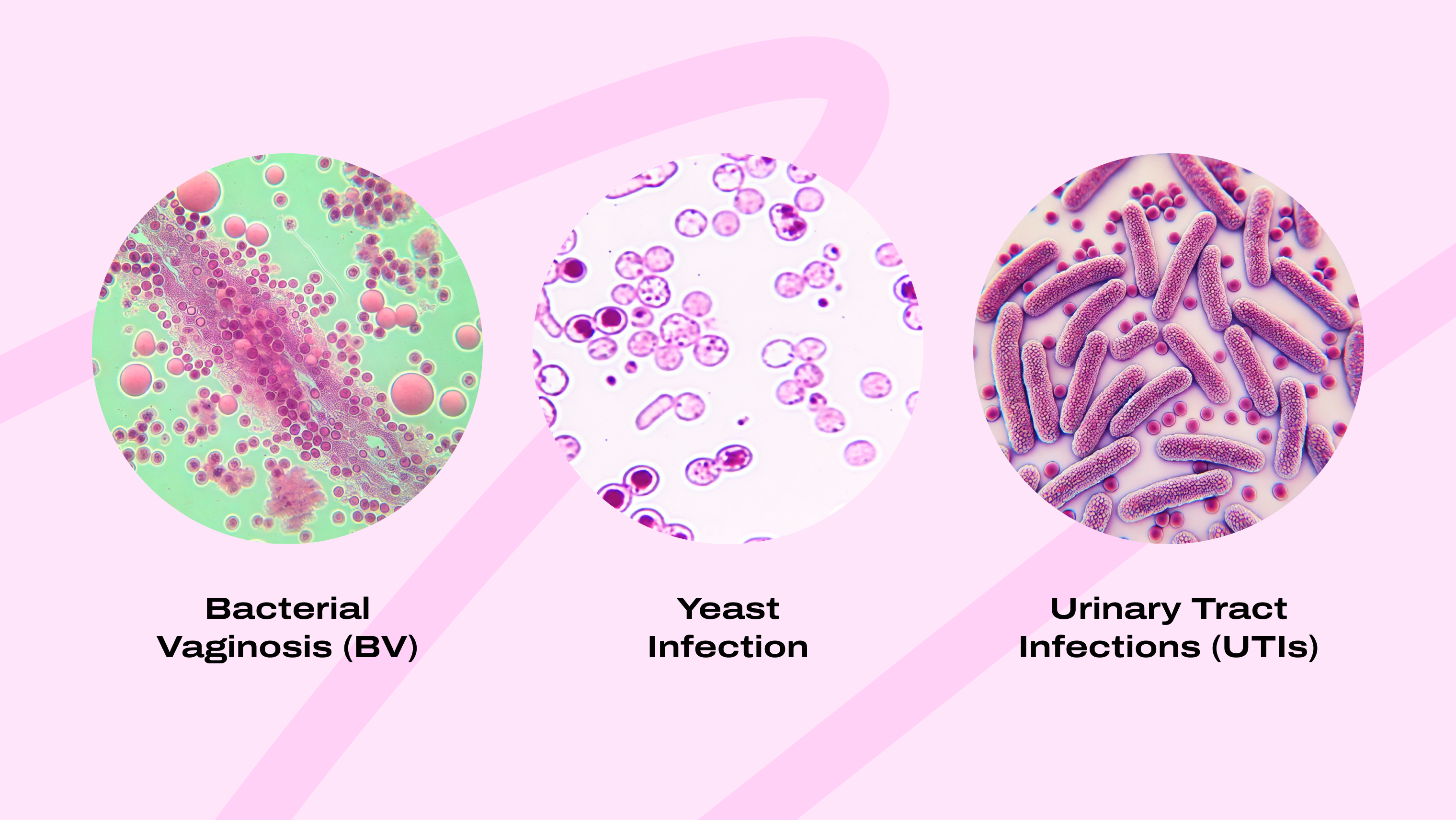Bacterial Vaginosis (BV), yeast infections, and urinary tract infections (UTIs) are three distinct conditions, though they are often confused due to their overlapping symptoms and how they affect women’s health.
Each condition requires a unique diagnosis and treatment, making it crucial to understand the differences.

Statistics on Vaginal Diseases

Case 1: Sarah's Struggle with BV
Sarah, a 32-year-old marketing professional, experienced BV for the first time last year. “I noticed a strong fishy odor after sex and felt incredibly self-conscious. The discharge was thin and watery, unlike anything I’d experienced before. I tried over-the-counter treatments, thinking it was a yeast infection, but nothing worked. When I finally saw my doctor, she diagnosed BV and prescribed probiotics. After a week, I felt much better. Now, I make sure to practice good hygiene and take probiotics to prevent recurrence.”
Symptoms of BV:
- Discharge: Thin, watery, grayish-white discharge with a strong, fishy odor.
- Itching: Mild vaginal itching or irritation, though it’s less common.
- Burning: Mild burning sensation during urination.
- Odor: The fishy smell is more noticeable after sexual intercourse.
Factors That Can Increase the Risk of BV:
Sexual Activity:
- New/Multiple Partners: Increases the risk of disrupting vaginal flora.
- Unprotected Sex: Semen can alter vaginal pH, promoting bacterial growth.
- Same-Sex Relationships: Sharing vaginal secretions can disturb the natural balance.
Douching: Cleanses away healthy bacteria, creating a favorable environment for harmful bacteria.
Hormonal Changes:
- Menstruation and Pregnancy: Hormonal shifts can affect vaginal pH and increase susceptibility to BV.
Poor Hygiene:
Improper Wiping: Can introduce harmful bacteria into the vagina.
Harsh Soaps: Irritate and disrupt bacterial balance.
Tight or Non-Breathable Clothing: Traps moisture, encouraging bacterial overgrowth.
Smoking: May weaken the immune system and affect vaginal flora.
Antibiotic Use: Disrupts the balance of healthy bacteria.
IUD Use: Some studies link copper IUDs to an increased risk of BV.
Low Levels of Lactobacilli: Naturally low levels of protective bacteria can increase BV risk.
Stress and Poor Health: Weaken the immune system, making it harder to maintain a healthy bacterial balance.
Treatment of BV:
Treatment for BV generally includes prescription antibiotics, either oral or topical (such as metronidazole or clindamycin). Home remedies, such as probiotics, can be useful for prevention but should not replace prescribed treatments.
Doctor’s Recommendation: Feminine Fresh Probiotics contains 5 probiotic strains and 20 billion CFUs that help protect against vaginal odor, yeast infections, BV (bacterial vaginosis), and UTIs, while also normalizing vaginal pH levels.
It exceeds what other players in the market offer. The results were tested, and over 1,000 women reported noticeable improvements within a month, with up to 70% experiencing long-term relief from BV. I observe these results in my patients and highly recommend this treatment.
Half Price Special – Don’t Miss Out!

Consequences of Untreated BV:
If left untreated, BV can lead to more serious health issues, such as:
- Pelvic inflammatory disease (PID): Can lead to infertility.
- Increased risk of STDs: Including HIV, chlamydia, and gonorrhea.
- Complications in pregnancy: Premature birth or low birth weight.

Case 2: Emma's Recurrent Yeast Infections
Emma, a 25-year-old yoga instructor, has been dealing with recurrent yeast infections for years. “Every few months, I get the same symptoms—intense itching and thick discharge. I’ve tried every over-the-counter medication available. While they help, the infection always seems to come back. My doctor suggested changing my diet and wearing loose clothing to prevent moisture buildup. I also started taking antifungal medication as a preventive measure, which has made a huge difference.”
Symptoms of a Yeast Infection:
- Discharge: Thick, white, cottage cheese-like discharge without a strong odor.
- Itching: Intense itching and irritation in and around the vagina.
- Burning: Painful burning sensation during urination or intercourse.
- Redness and Swelling: Swelling, redness, and soreness around the vaginal area.
Factors That Increase the Risk of Yeast Infections:
- Antibiotics: Disrupt healthy bacteria, allowing yeast overgrowth.
- High Estrogen Levels: From pregnancy, birth control, or hormone therapy.
- Uncontrolled Diabetes: High blood sugar promotes yeast growth.
- Weakened Immune System: Lowers the body’s ability to control yeast.
- Tight/Non-Breathable Clothing: Traps moisture, encouraging yeast.
- Douching/Scented Products: Disrupt the natural balance in the vagina.
- High-Sugar Diet: Excess sugar supports yeast growth.
- Sexual Activity: Friction or irritation can trigger infections.
- Hormonal Changes: Menstruation, pregnancy, or menopause increase risk.
- Poor Hygiene: Improper cleaning can disturb vaginal balance.
Treatment of Yeast Infection:
Treatment typically involves antifungal medications like fluconazole or over-the-counter creams and suppositories (e.g., clotrimazole or miconazole). Many women find quick relief with these treatments.
Doctor’s Recommendation: Feminine Fresh Probiotics contains 5 probiotic strains and 20 billion CFUs that help protect against vaginal odor, yeast infections, BV (bacterial vaginosis), and UTIs, while also normalizing vaginal pH levels.
Half Price Special – Don’t Miss Out!
Consequences of Untreated Yeast Infections:
While not typically dangerous, untreated yeast infections can lead to:
- Chronic infections: Recurrent episodes.
- Complications for pregnant women: Increased risk of preterm delivery.

Case 3: Jessica's UTI Nightmare
Jessica, a 28-year-old nurse, shared her experience with recurrent UTIs. “The burning was unbearable, and I felt like I had to urinate every few minutes, but nothing would come out. I didn’t realize how serious it was until I ended up in the ER with a kidney infection. My doctor explained that UTIs can lead to more serious issues if untreated. Now, I’m much more careful about staying hydrated, and I take cranberry supplements to prevent infections."
Symptoms of a UTI:
- Painful urination: Burning sensation when urinating.
- Frequent urination: Urge to urinate often but only passing small amounts.
- Cloudy or bloody urine: Urine that appears cloudy, dark, or has a strong smell.
- Pelvic pain: Pressure or pain in the lower abdomen or pelvic area.
- Fever: In more severe cases, especially if the infection has spread to the kidneys
Factors That Increase the Risk of UTIs:
-
Female Anatomy: Women have a shorter urethra, making it easier for bacteria to reach the bladder.
-
Sexual Activity: Frequent or vigorous sexual activity can introduce bacteria into the urinary tract.
-
Certain Birth Control Methods: Diaphragms or spermicides can increase the risk of UTIs.
-
Control Methods: Diaphragms or spermicides can increase the risk of UTIs.
-
Menopause: Hormonal changes reduce protective vaginal bacteria, increasing UTI risk.
-
Urinary Tract Abnormalities: Structural issues or blockages can prevent proper urine flow, promoting bacterial growth.
-
Catheter Use: Increases the chance of introducing bacteria into the urinary tract.
-
Suppressed Immune System: A weakened immune system makes it harder to fight infections.
-
Holding Urine: Delaying urination allows bacteria to multiply in the bladder.
-
Dehydration: Not drinking enough water can prevent regular flushing of bacteria from the urinary tract.
-
Recent UTI History: Previous infections increase the likelihood of recurrence.
Treatment of UTI:
UTIs are treated with antibiotics, with common options including trimethoprim-sulfamethoxazole or nitrofurantoin. It's essential to complete the prescribed antibiotic course to avoid recurrence.
Doctor’s Recommendation: I often recommend UTI Defence to patients seeking to reduce the frequency of urinary tract infections (UTIs). This supplement, which combines cranberry extract and vitamin C, offers a natural and effective approach. UTI Defence serves as a great alternative or complement to traditional treatments, especially for those looking to minimize antibiotic use.
Half Price Special – Don’t Miss Out!
Consequences of Untreated UTIs:
If a UTI is not treated, it can lead to:
- Kidney infections (pyelonephritis): Which can cause permanent damage to the kidneys.
- Sepsis: A life-threatening condition due to the infection spreading into the bloodstream.

Instead of providing a simple output, we have compiled a table for you that highlights the most important factors, showing how they impact different women.

By analyzing these factors and testing them across a diverse group of women, we can confidently say that our product not only works but does so effectively.
To solve problems with UTIs:
Half Price Special – Don’t Miss Out!
To solve problems with BV and Yeast Infection:
Half Price Special – Don’t Miss Out!


